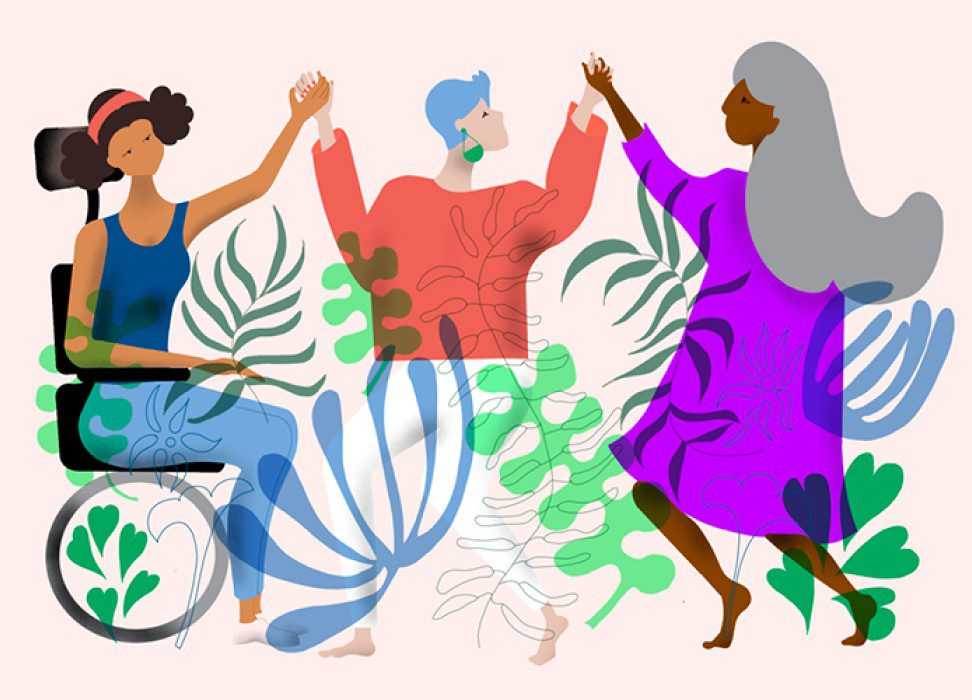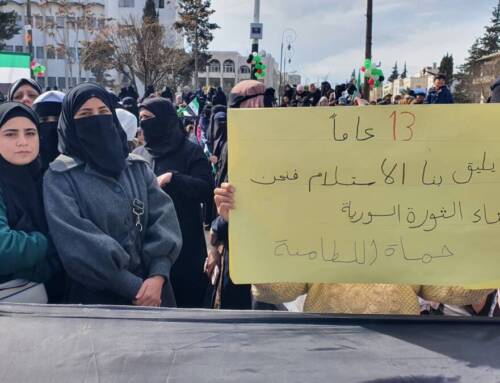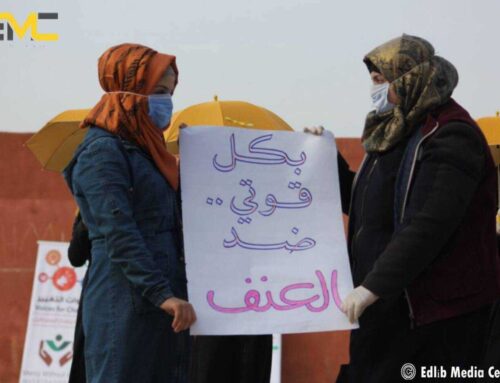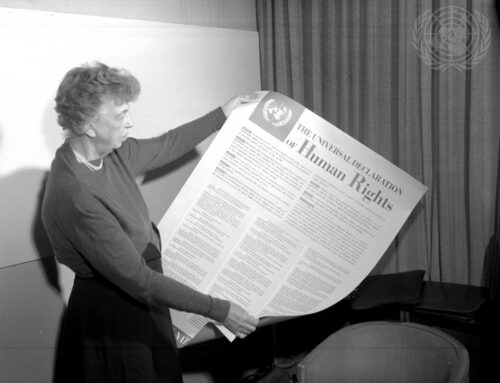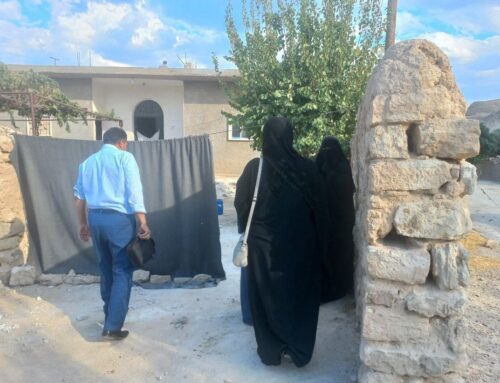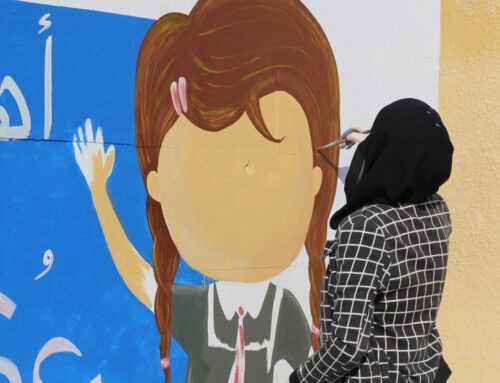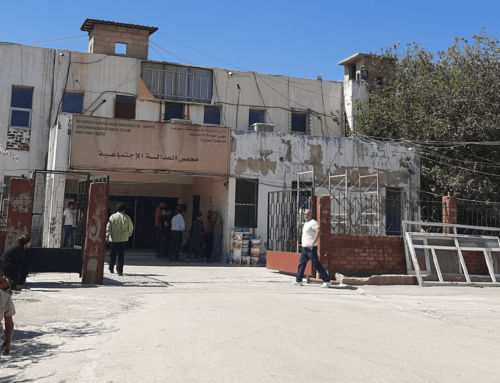Op-Ed: The way they are: The reality of women with disabilities
Social views and media portrayals of disabled women do not reflect their diverse lived realities, writes Syrian journalist and feminist activist Raghda al-Shamiya.
16 June 2022
A friend of mine became withdrawn at school and in her social life after developing alopecia areata—an autoimmune disorder that leads to hair loss from some or all of the body, especially the scalp—at a young age.
When her brother’s wedding came along, to appear in front of the guests in accordance with society’s beauty standards, my friend had no option but to buy a wig. I went with her to a wig shop in Damascus, where the seller showed her a variety of models and colors he considered to be fashionable. She chose one resembling a “natural” look.
In most Arabic-speaking societies, women with disabilities are not expected to work, marry or have children. Most live in isolation from the wider social and family environment. Even so, there are still demands to ensure a fair social, professional and family environment for them. This has led to the emergence of a number of institutions and advocacy bodies, such as the Mauritanian Association for Disabled Women, which is concerned with promoting and protecting women with disabilities. The Women’s Refugee Commission works to include women and girls with disabilities in the humanitarian field.
The question of naming
A controversy arises when it comes to defining and naming people who have an impairment or illness, whether physical, motor, mental, auditory or visual. These labels in themselves can be problematic, prompting questions about what label is correct for society and the media to adopt. One should be cautious about labels that lead to exclusion, discrimination and injustice. Do we say disabled people? Special needs?
The UN’s Office of the High Commissioner for Human Rights (OHCHR) uses the term “persons with disabilities” in most of its reports. All forms of media adopt both terms—disabled people and people with disabilities. The United Arab Emirates went as far as to launch the term “people of determination” in 2017.
The Syrian Female Journalists Network has had an important role in critical media analysis. The network uses the term “women with disabilities,” feminist journalist Rola Othman, SFJN’s Gender Radar Program Coordinator, said. But “work on appropriate language and terms in general is always developing,” and that label is not absolute or definitive. On a personal level, Othman chooses “the term the person in question prefers.”
Intentional exclusion
Arab drama often portrays women with disabilities as abused, pitiful and victims of rape and sexual harassment. This is especially true of women with mental illnesses and disabilities.
One example of this is the Egyptian film “Toot Toot,” produced in 1993. The story revolves around Kareema, a young woman with a mental disability who lives in a poor neighborhood, portrayed by actress Nabila Ebeid. In the film, Kareema is exploited by people who give her difficult work. She is also raped by a wealthy man who exploits her and leaves her pregnant in the center of the capital city.
In contrast, Arab drama portrays men with disabilities as examples of determination, intelligence and effectiveness. The 2010 Syrian series “Behind the Sun” focuses on Badr, a man with autism played by actor Bassam Kousa. In the series, Badr shows intelligence and skill, especially in his job making clocks.
The portrayal of women with disabilities in film and television does not reflect reality, which is full of distinct examples. In the Syrian context, writer Rima Khattab, 40, nicknamed the “novelist of the camps,” is one woman who has defied war, displacement and living in the camps.
Rima was given the polio vaccine in an improper way, and it did not prevent her from contracting the disease, “which led to a disability in my left foot,” she said. Despite a long journey of treatment, her health condition remains the same. Her disability caused her to be deprived of “completing my education, which only went as far as elementary school,” she said.
Rima fought to achieve her dream to write, and has authored “Gazelle of the Cave,” a novel about the reality of women with disabilities, as well as the novel “A Homeland in the Wind.” She has also written several short story collections about the lives of 25 successful Syrian women, as well as four collections about the Syrian people’s suffering as a result of war and displacement. She also wrote a collection of stories for children, and has been involved in children’s theater, documentaries and films.
“I created my own revolution to reach my dream. I built myself out of nothing,” Rima said. “People with disabilities are brilliant, geniuses.” She hopes her work will spread in the Arab world and internationally.
Hope is created from the depths of defying circumstances of life and the body, said Hanan (a pseudonym), 50. “My life wasn’t stable before my injury. I was married for 14 years, and had marital problems that ended in separation after I had two children,” she said. Despite her university education, she feared the social stigma of the word “divorced.”
In April 2014, Hanan was injured by a missile that landed where she was walking in Idlib province. She woke to find she had lost her left foot. After her injury, she faced a new battle “with my family, which did not support me either before or after my injury. Despite the psychological and social circumstances she went through, her challenge became “to be or not to be.”
For Hanan, the first step toward creating hope was to leave Syria for treatment in a European country, despite her family’s refusal “because I am a woman.” She says her injury created “a woman who can do anything, no matter what injures her.” In 2016, she founded a project to support and empower wounded women.
Hanan’s path has not been easy, and she went through extremely difficult economic conditions. She made a living by teaching at home, then completed a master’s degree and is currently working on a doctorate. Alongside that, Hanan got her driver’s license, and opened a business selling wooden items and accessories in her home three years ago.
Hanan offers initiatives from time to time aimed at supporting women’s small projects, and has joined a number of associations advocating for women’s issues. Through them, she has encountered many struggling women who succeeded in defying difficulties and proved that women, with their knowledge and culture, can do the impossible. Those experiences included injured women establishing small businesses with support from the rehabilitation center Hanan started.
Some husbands leave their wives because of their injury or physical disability, according to Hanan. But “happiness is not only a man’s presence in a woman’s life,” she said. “Rather, a man’s presence can be an injustice and an insult to her and her potential and abilities.”
Doubled violence
In March, Egypt’s National Council for Women announced the results of a study on violence against women with disabilities. The study surveyed 5,616 women, and found that 61 percent of married women were beaten by their husbands. Some 43 percent of those women experienced disability-based violence, including harassment in public places.
According to a 2013 UN report, “women with disabilities are at a higher risk of becoming victims of domestic violence as opposed to women without disabilities; are likely to experience abuse over a longer period of time; and, they suffer injuries that are more severe as a result of the violence.” The report noted that disabled women, in institutional settings, face “multiple forms of violence, including forced intake of psychotropic drugs or other forced psychiatric treatment,” saying that “forced institutionalization itself constitutes a form of violence.”
Women in general, and in Arabic-speaking societies, face abuse and are judged on the basis of their outward appearance. Women and girls with disabilities, regardless of the type of disability, live in precarious conditions and suffer from gender discrimination. This results in domestic and sexual violence, in addition to verbal violence such as expressions of pity that can cause psychological harm.
Women with disabilities may be afraid to express their emotional and sexual feelings, or refrain from participating in some public activities because of their disability. For that reason, some may turn inwards, as in the case of my 32-year-old friend, who I accompanied to buy a wig in Damascus.
Although her family, unlike others, was psychologically supportive of her, her illness and society’s view “deprived me of my childhood,” she said, especially when called “toxic” nicknames or enduring comments such as “what a shame, she’s bald with no hair.”
All that caused her to isolate and not integrate with relatives and the community, to the point that she refused to marry so as not to be seen “as less than, or [face] refusal.” Instead, she continued her education, seeking financial and professional independence.
This article was originally published in Arabic and translated into English by Mateo Nelson.

